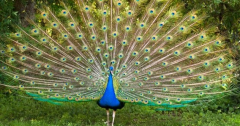The term “bird-brained” is often used to describe something simple or dopey. So it might surprise you to learn that our feathered friends are more complex creatures than we frequently give them credit for. From Kenya’s charitable starlings to the toxic avians of Papua New Guinea, there are fascinating birds to be found all over the planet.
The following list covers avians galore, including a gender-splitting honeycreeper, a record-breaking albatross mother, and a scientist using an ultralight to teach ibises how to migrate. The birds in this list aren’t halfwit airheads. Here are some of the most fascinating bird discoveries nature has to offer.
Related: 10 Fascinating Discoveries Made by the Aztecs
10 Laser Peacocks
20-Year-Old Student Uses Peacock Feathers to Create Lasers: A Groundbreaking Discovery
Peacocks are well known for rattling their feathers in a dazzling display of color. Scientists in the U.S. saw the birds’ lavish plumage and thought, “We can make lasers out of those.” And, remarkably, they did.
Peacock feathers get their iridescence from complex nanostructures that scatter light in a shimmer of color. These ordered patterns are known to physicists as photonic crystals. They allow some wavelengths of light to pass through while blocking others.
In a 2025 paper in Scientific Reports, researchers at Florida Polytechnic explained how they took feathers from male Indian peafowl (Pavo cristatus) and used them as a medium to generate laser light. First, the team applied a dye, then fired light pulses at the stained feathers.
Remarkably, they found that the peafowl’s eyespots glowed, emitting several bands of color, including an intense green light. However, researchers are still unsure precisely which structures caused the glow. They hope that one day their work can help build biocompatible lasers that can be used in the human body.[1]
9 The Split Personality Bird
Extremely rare half-female, half-male Green Honeycreeper
Birdwatcher John Murillo was astounded to discover a green honeycreeper (Chlorophanes spiza) that was both male and female. Male honeycreepers typically sport blue plumage. Females, on the other hand, live up to their name with a lovely green coat. But this individual was split down the middle—one side blue and the other green.
Scientists say that this trait, bilateral gynandromorphy, is extremely rare in honeycreepers. This bird was the second case ever recorded in that species, and the first in over a century.
Murillo came across the bird in 2021 near Manizales, Colombia. He and a team of zoologists studied the rare creature for nearly two years. They found that it behaved much like a regular honeycreeper, but it was a little more solitary and showed no drive to find a mate.
Scientists believe that bilateral gynandromorphism takes place when an egg undergoes unusual chromosomal division and is fertilized by different sperm, producing both male and female characteristics. They never studied the bird closely enough to learn about its internal organs, but they suspect it likely had both male and female systems.[2]
8 Supermom Albatross
The world’s oldest known bird Wisdom the Laysan albatross lays new egg at 74-years-old | ABC News
The headlines were abuzz in late 2024 after Wisdom, the world’s oldest wild bird, laid an egg and prepared for her next chick at the age of 74. The U.S. Fish and Wildlife Service filmed the veteran Laysan albatross (Phoebastria immutabilis) at a Pacific refuge as she and her partner tended to the egg.
Wisdom is already a prolific layer. Experts estimate she has mothered over 30 chicks during her long life. Her last young one emerged in 2021.
Laysan albatrosses typically live up to 40 years. However, Wisdom has defied all expectations and is still thriving well into her seventies. She was first tagged at the age of five in 1956. Her species usually mates for life, although scientists believe she has outlived at least three partners.
Wisdom, her latest partner, and her new chick live a peaceful life at the Midway Atoll National Wildlife Refuge in the Hawaiian archipelago, which boasts the largest albatross colony in the world.[3]
7 Bird Besties
African Superb Starling Splendor of the Savannah Birdwatcher’s Guide
Starling relationships are much more similar to human ones than you might think. The birds are known for breeding cooperatively. Come mating season, some superb starlings (Lamprotornis superbus) choose not to breed and instead help their buddies raise chicks. Now, scientists have found that the relationship goes both ways.
In a 2025 study, a team at the University of Cambridge discovered that the helper birds will receive assistance in return when it’s their turn to raise chicks. They studied over 400 nests in Kenya across nine social groups spanning about 15 years.
Superb starlings tend to pair up. Often, relatives born in the same nest will choose each other. One bird becomes the breeder, and the other takes on the role of helper. Experts say this give-and-take system is essential for surviving in an unforgiving climate with little food and frequent droughts.[4]
6 Before Birds Were Birds
The Evolution of Birds: From Feathered Dinosaurs to Flight | FULL DOCUMENTARY
Over 210 million years ago, strange beings with bird-like feet wandered through southern Africa—60 million years before the earliest known birds.
Scientists examined animal tracks from sites across Lesotho. Geologists from the University of Cape Town studied 163 footprints that date back to the Late Triassic and Early Jurassic periods.
Fossil evidence suggests that birds first evolved around 150 to 160 million years ago. Scientists are unsure if these new tracks were made by some sort of unknown early ancestor or by a separate species that developed bird-like feet long before birds themselves evolved.[5]
5 Shrinking Birds, Growing Wings
Why some animals are shrinking
The animal kingdom is constantly changing. Just look at the Amazon, where birds are shrinking while their wings are growing longer. Scientists have reported that both migratory and non-migratory birds are dwindling in size. Some species have dropped nearly 10% over the past 40 years.
Experts at the Amazon Biodiversity Center near Manaus have been studying birds for decades. They use mist nets to capture birds from a set area, then weigh them and measure their wings.
The team found that almost every one of the 77 species caught had shrunk over the last 40 years. In about





